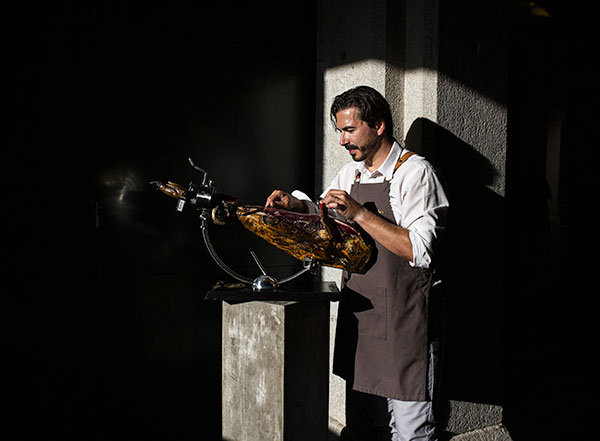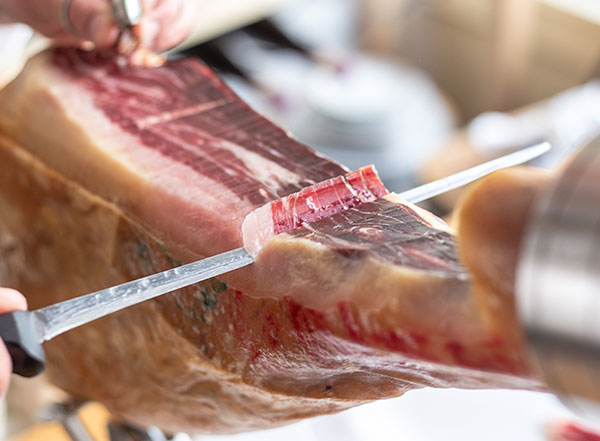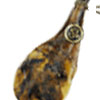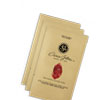Discover the steps to cutting your Cinco Jotas jamón like an expert master carver and achieve the perfect slice.
Before starting to slice any of our Cinco Jotas 100% Iberian acorn-fed hams you must first learn to identify the different parts.
• Maza (cushion) The juiciest part, marbled with fat, where we recommend that you start cutting the ham. This is the easiest part to cut, where you can also carve the most attractive slices. It's also simpler to keep this part fresh for longer.• Babilla (fore cushion) The most highly cured part of the ham.
• Punta (ham end) A area with an intense flavour.
•Jarrete or codillo (the hock or shank) A part that is nearer to the hoof, characterised by being very flavourful with sweet notes.

Where should you start to cut a ham?
We also need to take these three rules into account to make the most of a Cinco Jotas jamón:
• Keep the lines straight when cutting the ham.
• Keep the surfaces flat.
• Clean off the different bones.
During the process you will need three different types of knives:
• A butchers knife, with a wide, thick blade to remove the outer layers of fat.
•A sharp knife, with a narrow, pointed blade to remove the meat from the bones.
• A special ham carving knife with a long, flexible blade.
To start cutting the ham, use the carving knife to cut across the ham, three fingers below the codillo (hock) until you reach the bone. To make the first cuts the ham should be positioned with the hoof pointing upwards. Then, remove the layer of fat that protects the ham during the curing process. Make the most of the versatility of positioning that the ham stand allows you to move the piece when cutting. You should only uncover the part that you want to carve. The aim of these cuts is to reach the white fat and then start carving the muscle. We recommend saving some slices of fat to protect the ham from oxidation.
What technique should you use to get the perfect slice? That small, thin slice that melts in the mouth.
Place the heel of the knife, the area closest to the handle, on the maza, keeping the blade straight, applying a little bit of pressure and gently gliding the knife from left to right as you cut towards you. Use ham tweezers to remove the slices of jamón de bellota. The first slices of the jarrete should be carved by sliding the knife upwards, keeping the lines straight, to make the most of the whole ham. Then, continue cutting from the jarrete (hock) towards the maza. During this process you will be able to appreciate the colour and fat marbling that speaks volumes about the quality of Cinco Jotas hams.

Obstacles during carving:
• The first obstacle that you will reach when carving the maza is the hip bone. Use the small, sharp knife with a pointed tip to remove the meat. Then use the ham carving knife to start removing the first slices from the punta (ham end), sliding the knife from one end to the other.
• The second difficulty you will encounter is the fibula. Remember the rule of keeping the surfaces flat and make a small incision in front of the fibula before continuing carving. Alternate between cutting one slice towards you and one slice in the other direction.
• The next bone to appear is the knee bone. As before, make a small cut behind it and alternate between cutting slices towards you and slices away from you, creating two steps.
• Next to appear will be the hip bone, where you will need to separate the meat from the bone to make it easier to remove the slices. Start carving by sliding the knife from the handle towards the tip of the blade to get one of the most delicious slices of Cinco Jotas ham. The perfect combination of fat and lean meat.
After reaching the bone, it is time to turn the ham over to start carving the babilla or fore-cushion. You need to remove the layers of oxidised fat from the ham as you did when carving the maza. This part of the ham is characterised by its intense, long-lasting flavour and firm texture. When the knee bone appears, the first cut should be made away from you. Make a small cut behind the knee so that the slice can be removed with ease. To carve the slices of meat around the hip bone, as the bone will be on your right, you will need to turn the knife over and use the other side of the blade to slide from the heel of the knife towards the tip.
The final slices of 100% Iberian acorn-fed ham:
Once the hip and knee bones are exposed, keep carving the babilla until you reach the femur. Once you reach the femur bone, this cut is finished. Turn the Cinco Jotas jamón on its side in the ham stand to continue with the third cut. You can alter the angle of the knife to make a shorter or longer slice. Continue to carve on the diagonal, passing from the hip to the femur and knee bones.
The final step will be to remove the fibula bone to get at the rest of the hock meat. We recommend cubing the meat from the femur area to use in stews and croquettes. Are you ready to become a real master carver?






